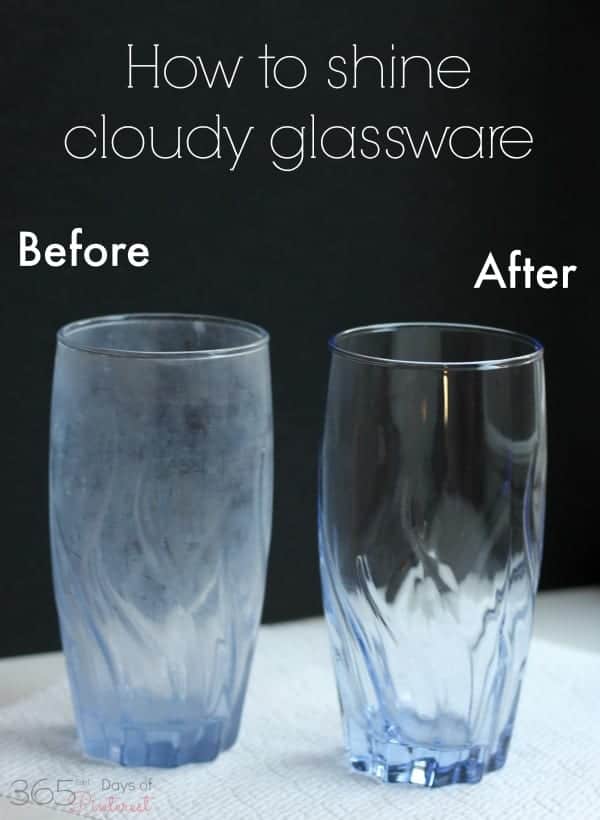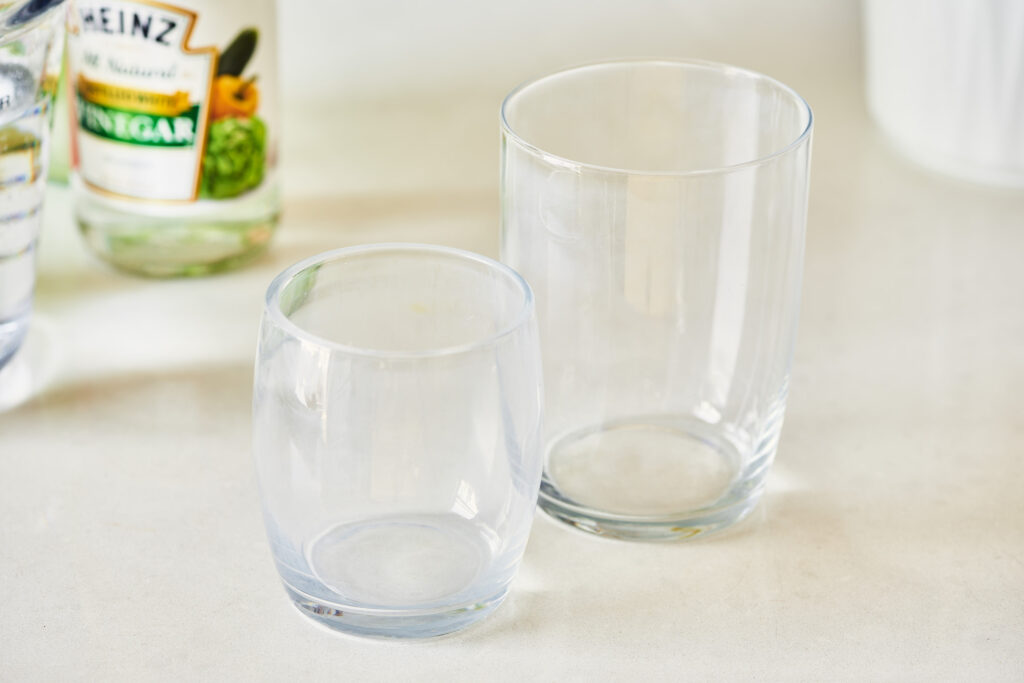
In this article, you will discover practical and efficient ways to troubleshoot the issue of cloudy glassware in your dishwasher. We all love sparkling, crystal-clear glasses to sip our favorite beverages, and finding them hazy or cloudy after a dishwasher cycle can be a bit frustrating. Fear not, as we will provide you with simple yet effective solutions to tackle this problem head-on. From adjusting your dishwasher settings to using specific cleaning products, we’ve got you covered to ensure your glassware comes out brilliantly clear every time.

This image is property of simpleandseasonal.com.
Inspect Your Dishwasher
Check the water temperature
The first step in troubleshooting cloudy glassware in your dishwasher is to check the water temperature. Make sure the water entering the dishwasher is hot enough to effectively clean your dishes. The ideal water temperature for a dishwasher is between 120 and 125 degrees Fahrenheit. Anything lower than that may not be sufficient to remove food particles and stains from your glassware.
Check the water hardness
Another factor that can contribute to cloudy glassware is hard water. Hard water contains high levels of minerals, such as calcium and magnesium, which can leave behind a residue on your dishes. To check the water hardness, you can purchase a water hardness test kit from your local home improvement store. If you find that the water hardness is high, you may need to consider using a water softener or a dishwasher cleaner specifically designed to tackle hard water stains.
Inspect the dishwasher spray arms
The spray arms in your dishwasher play a crucial role in ensuring that water is distributed evenly and efficiently throughout the dishwasher. Over time, these spray arms can become clogged with food particles or mineral deposits, affecting the overall performance of your dishwasher. Inspect the spray arms and clean them if necessary. You can use a toothpick or a small brush to remove any debris that may be blocking the spray nozzles.
Inspect the dishwasher filter
A clogged dishwasher filter can also contribute to cloudy glassware. The dishwasher filter captures food particles and debris during the wash cycle, preventing them from circulating and redepositing on your dishes. However, if the filter is clogged, it can impede the water flow and lead to inadequate cleaning. Inspect the dishwasher filter and clean it as needed. Refer to your dishwasher manual for instructions on how to remove and clean the filter properly.
Check the Detergent
Use the appropriate detergent
Using the appropriate dishwasher detergent is essential for achieving clean and clear glassware. Different detergents are designed for different water conditions and levels of soil. If you have hard water, consider using a dishwasher detergent specifically formulated for hard water. Similarly, if your water is soft, opt for a detergent suitable for soft water. Using the right detergent for your water conditions will help prevent mineral deposits from forming on your glassware.
Check the detergent amount
Using too much or too little detergent can affect the cleanliness of your glassware. Too much detergent can result in excess suds and a film residue on your dishes, while too little detergent may not effectively remove food particles and stains. Consult your dishwasher manual or the detergent packaging for guidelines on the recommended amount of detergent to use. Adjust the amount if necessary and ensure that the detergent dispenser is functioning correctly.
Pre-rinse dishes if necessary
If you consistently experience cloudy glassware, it may be helpful to pre-rinse your dishes before loading them into the dishwasher. Pre-rinsing can help remove any food particles or residue that may contribute to cloudy glassware. However, keep in mind that modern dishwashers are designed to handle most food soils, so pre-rinsing is often not required. If you do choose to pre-rinse, use warm water and a gentle dish soap.

This image is property of www.thespruce.com.
Load the Dishwasher Correctly
Avoid overcrowding the dishwasher
One common mistake when loading the dishwasher is overcrowding the racks. When there is insufficient space between dishes, water and detergent may not be able to reach all surfaces effectively, leading to poor cleaning and cloudy glassware. Take the time to properly arrange your dishes, leaving enough room for water and air to circulate. Avoid stacking items on top of each other, as this can prevent proper water distribution.
Place glassware properly
The way you position your glassware in the dishwasher can also impact its cleanliness and clarity. To avoid cloudy glassware, place glasses and cups upside down on the dishwasher rack. This position allows water to drain away from the interior surface, reducing the chance of water spots or residue. Additionally, ensure that the glasses are spaced apart to prevent them from touching each other during the wash cycle.
Separate glassware from silverware
To prevent silverware from coming into contact with your glassware and causing scratches or cloudiness, it is important to separate the two. Use the designated silverware basket or compartment in your dishwasher to keep silverware separate from your glassware. This will help preserve the quality and appearance of your glassware.
Use Rinse Aid
Check if rinse aid is needed
Rinse aid is a helpful addition to your dishwasher routine, especially if you frequently experience cloudy glassware. Rinse aid is designed to reduce water droplet formation and encourage water to flow off dishes more easily, preventing spots and streaks. Check if your dishwasher has a rinse aid compartment or dispenser. If it does, consider using a rinse aid product to improve the clarity of your glassware.
Add rinse aid to the dishwasher
If your dishwasher has a rinse aid compartment, follow the manufacturer’s instructions to fill it with rinse aid. Some dishwashers have a dial or setting to adjust the amount of rinse aid dispensed with each cycle. Experiment with different settings to find the optimal amount for your specific dishwasher and water conditions. Remember to refill the rinse aid compartment regularly to ensure consistent results.

This image is property of storage.googleapis.com.
Run a Hot Water Cycle
Run the hot water faucet before starting the dishwasher
Before starting a dishwasher cycle, it is important to run the hot water faucet in your kitchen to ensure that hot water is readily available. This helps the dishwasher start with hot water, promoting effective cleaning and preventing the possibility of cloudy glassware. Let the faucet run until the water becomes hot, and then start the dishwasher immediately afterward.
Select a hot water cycle
Most dishwashers offer different wash cycle options, including those with varying water temperatures. To help prevent cloudy glassware, select a hot water cycle if available. Hot water can better dissolve detergent and remove stains, ensuring that your glassware comes out sparkling and clear. If your dishwasher does not have specific cycle temperature settings, opt for the longest cycle available as it is likely to use hotter water.
Clean the Dishwasher
Remove buildup from the dishwasher
Over time, mineral deposits, detergent residue, and food particles can accumulate inside your dishwasher. This buildup can contribute to cloudy glassware and affect the dishwasher’s performance. To clean your dishwasher, start by removing any visible debris or food particles from the bottom of the dishwasher tub. Then, wipe down the interior surfaces using a damp cloth or sponge. Pay special attention to areas with buildup, such as the sides, door edges, and around the detergent dispenser.
Clean the spray arms
Clean and free-flowing spray arms are essential for the proper functioning of your dishwasher. Remove the spray arms from the dishwasher and inspect them for any clogs or blockages. Clear any debris with a toothpick or a small brush. You can also soak the spray arms in warm soapy water to dissolve any stubborn residue. Once clean, securely reattach the spray arms to ensure they rotate freely during a wash cycle.
Clean the dishwasher filter
As mentioned earlier, a clogged dishwasher filter can hinder water flow and prevent effective cleaning. To clean the filter, consult your dishwasher manual for specific instructions, as the location and removal process may vary depending on your dishwasher model. Remove the filter and rinse it under warm water to remove any trapped debris. Use a brush or toothbrush to gently scrub away any stubborn residue. Once clean, reinstall the filter and ensure it is securely in place.
Run a dishwasher cleaner cycle
In addition to regular cleaning, running a dishwasher cleaner cycle every few months can help remove built-up residue, eliminate odors, and improve overall dishwasher performance. Follow the instructions on the dishwasher cleaner product for the best results. Typically, this involves placing a dishwasher cleaner tablet or powder in an empty dishwasher and running a hot water cycle. This will help ensure that your dishwasher is clean and ready to produce sparkling glassware.

This image is property of blogs.extension.iastate.edu.
Check Water Quality
Test the water hardness
To tackle the issue of cloudy glassware, it is crucial to test the hardness of your water. Hard water can leave behind mineral deposits on your glasses, leading to a hazy or cloudy appearance. You can purchase a water hardness test kit from a home improvement store or consult a water testing service to determine the hardness of your water. Knowing the hardness level can help you take appropriate measures to combat the issue.
Consider using a water softener
If your water hardness is high, it may be necessary to install a water softener to reduce mineral content. Water softeners work by removing the excess minerals from the water supply, preventing them from depositing on your glassware. Consult a professional plumber to determine the best type of water softener for your home and to ensure proper installation. Using a water softener can significantly improve the clarity of your glassware and prevent future buildup.
Check for Hard Water Stains
Find and remove hard water stains from glassware
If you notice hard water stains on your glassware, it is important to address them promptly. Hard water stains can be stubborn and difficult to remove, but there are several methods you can try. One effective solution is to soak your glassware in a vinegar or baking soda solution. Simply fill a basin or sink with equal parts warm water and vinegar or baking soda, and let the glassware soak for a few hours or overnight. Rinse thoroughly afterward, and the stains should be significantly reduced or eliminated.

This image is property of arc-anglerfish-washpost-prod-washpost.s3.amazonaws.com.
Contact the Manufacturer
Consult the dishwasher manual
If you have exhausted all troubleshooting methods and are still experiencing cloudy glassware, it may be time to consult the manufacturer of your dishwasher. Check the dishwasher manual that came with your appliance for troubleshooting tips specific to your model. The manual may provide additional insights or recommended steps to resolve the issue.
Contact customer support for assistance
If the cloudy glassware problem persists despite your best efforts, reach out to the customer support team of the dishwasher manufacturer. They have trained professionals who can provide guidance and assistance in troubleshooting the issue. Be prepared to provide specific details about your dishwasher model, the type of glassware affected, and the steps you have already taken to address the problem. The customer support team will be able to guide you further and provide additional recommendations or potential solutions.
Alternative Solutions
Hand wash glassware
If you continue to experience cloudy glassware and all other troubleshooting methods have been unsuccessful, you may need to hand wash your glassware temporarily. Hand washing allows for better control over the cleanliness and clarity of your glasses, ensuring that they come out spotless and clear every time. Use warm water, a gentle dish soap, and a soft sponge or cloth to clean your glassware thoroughly.
Use a different dishwasher
If all else fails and you are still unable to achieve clear glassware, it may be worth considering using a different dishwasher. Different dishwasher models may have varying performance capabilities, and switching to a more advanced or higher-quality dishwasher could potentially solve the issue. Research and consult reliable sources, such as consumer reviews or recommendations from professionals, to find a dishwasher known for its excellent glassware cleaning results.
Try vinegar or baking soda solution
As mentioned earlier, vinegar and baking soda solutions can be effective in removing hard water stains from glassware. If you encounter stubborn stains despite proper dishwasher maintenance, soak your glassware in a mixture of warm water and either vinegar or baking soda. Let the glassware soak for a few hours or overnight before rinsing thoroughly. This method can help restore the clarity of your glassware and remove any residue left behind by hard water.
In conclusion, troubleshooting cloudy glassware in your dishwasher involves a combination of inspecting your dishwasher, checking your detergent, loading the dishwasher correctly, using rinse aid, running a hot water cycle, cleaning the dishwasher, checking water quality, and exploring alternative solutions. By following these comprehensive steps, you can identify and address the underlying causes of cloudy glassware, ensuring that your dishes come out clean, clear, and sparkling every time.





